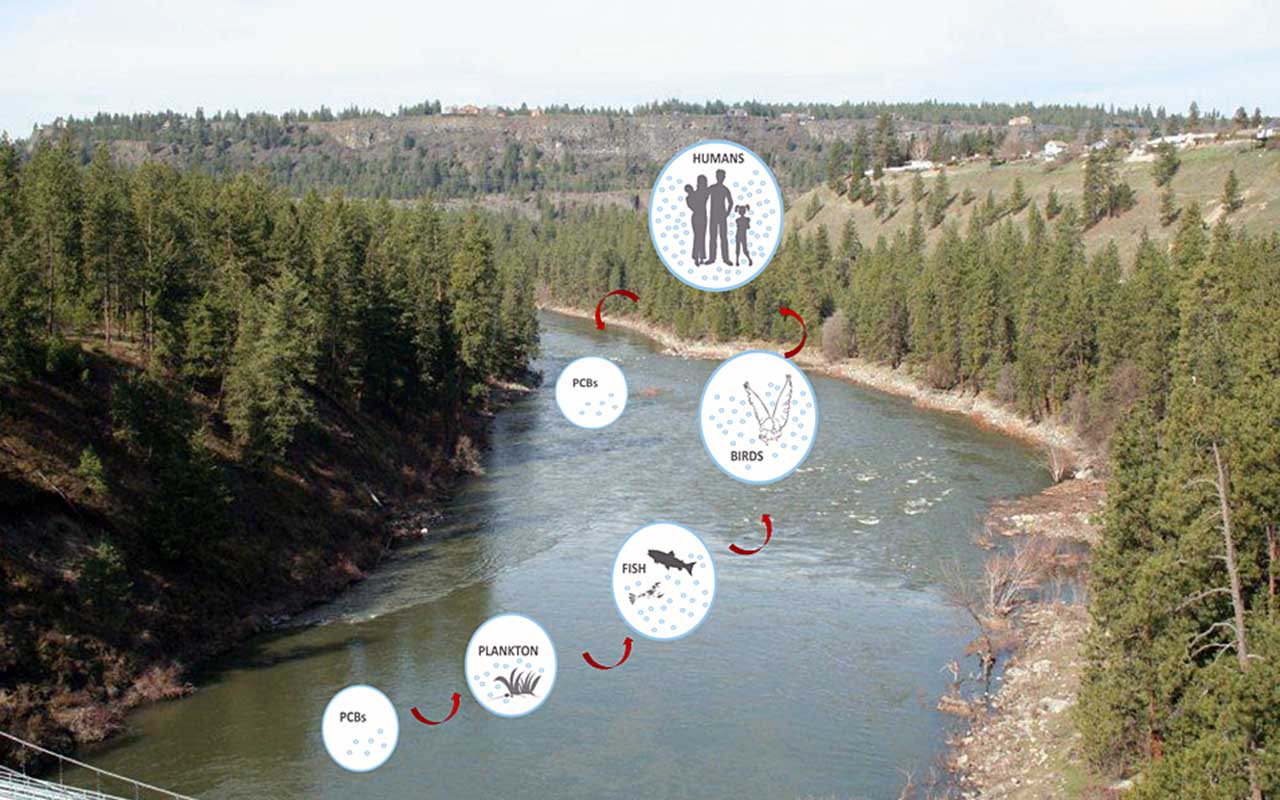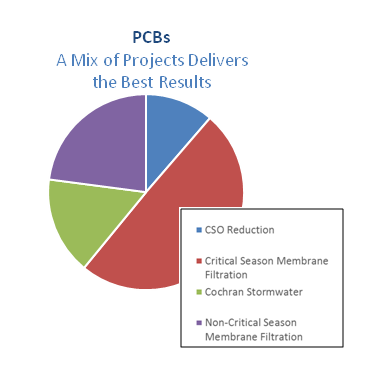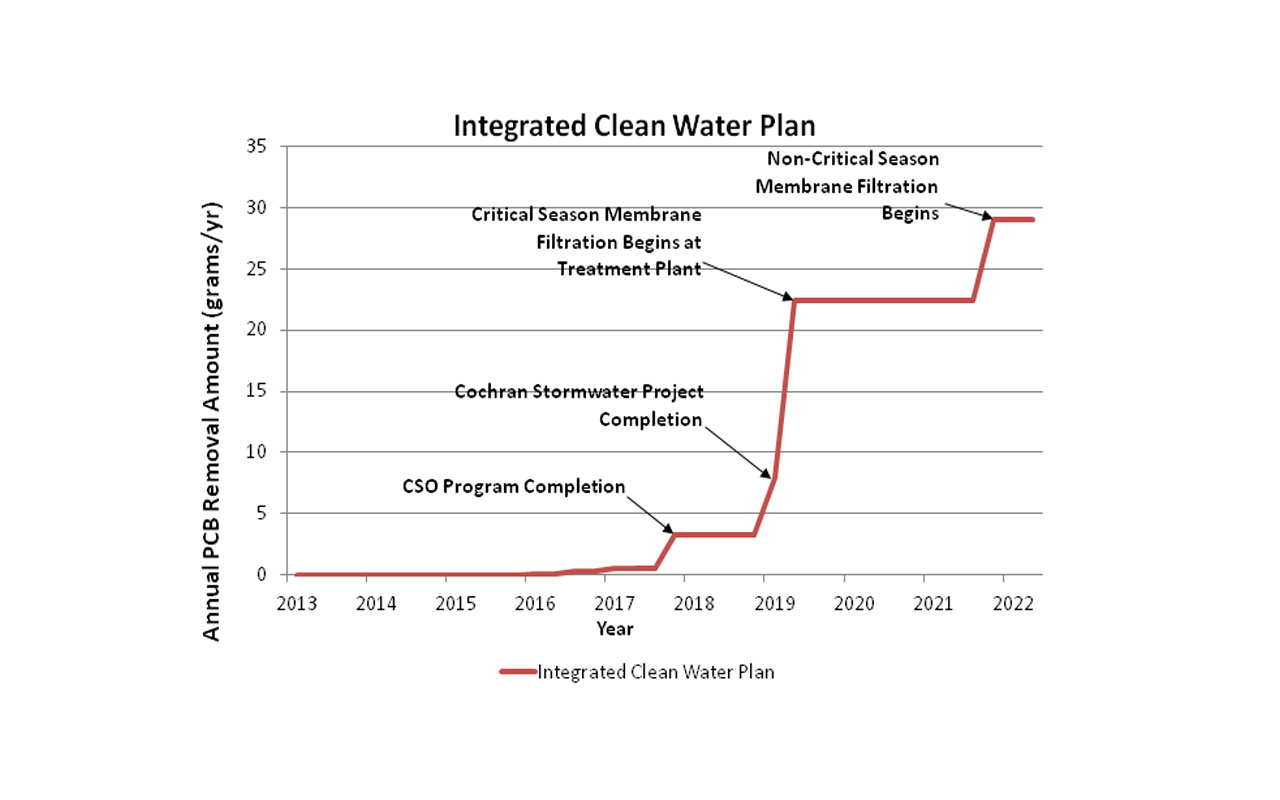PCBs
The City of Spokane is working to improve the health of the Spokane River and reduce the amount of pollution that enters it. One important pollutant of concern for the City is PCBs.
What are PCBs?
Polychlorinated biphenyls (PCBs) are a toxic manmade chemical found nearly everywhere in the environment. Historically, PCBs were primarily used in coolants and lubricants in electrical equipment, such as transformers and capacitors. In the United States, PCBs were largely sold under the trade name Aroclor. Direct production of PCBs was halted in the US in the 1970’s due to evidence of human toxicity and persistence in the environment. Since that time, however, PCBs have been incidentally produced in a multitude of manufacturing processes as an unintended byproduct of processes that use heat, chlorine, and carbon.
Low levels of PCBs can be found in our wastewater, stormwater, air, groundwater, and even in our own bodies. They enter the environment through a number of different pathways, including inks and dyes (paint, dyed clothing, colored paper and packaging, etc.), motor oil, gasoline, pesticides, personal care products, caulks, and many other products. These products are often enter the wastewater system or are washed off the roadway into the stormwater system and enter the river. Once released, PCBs do not break down easily and continuously cycle through the environment. PCB molecules prefer to stick to solids and fats rather than dissolve in water.
PCB concentrations increase in animals through the food web. Because there are PCBs present in the Spokane River and subsequently high concentrations of PCBs in its fish, the Department of Health has placed limits on the amount of fish you can eat from certain sections of the Spokane River.

PCBs Bioaccumulate in the Food Web
Integrated Clean Water Plan & PCBs
In 2024, the City of Spokane voluntarily adopted a comprehensive Integrated Clean Water Plan that is greatly enhancing the health of the Spokane River. The plan included projects to reduce overflows from combined sewers to the river, reduce stormwater runoff entering the river, and to improve the treatment at the City's wastewater treatment plant. The plan included work that is mandated and other voluntary work that just makes sense for the health of the river.

The plan took aim at a variety of pollutants to deliver magnitudes greater pollution reduction benefits to the river than if the City chose to complete only the work that was required by the Clean Water Act and other mandates.
PCBs and related toxics are of particular interest. The Spokane River and Lake Spokane are on the State of Washington's 303(d) list of impaired water bodies for PCBs. The EPA is currently developing a PCB Total Maximum Daily Load (TMDL) for the Spokane River. The City ranked PCB removal high when it evaluated the environmental benefits of the projects it selected for the Integrated Plan.
An analysis of PCB removal demonstrates the value of the City's Integrated Plan. Mandated projects would deliver about 17 grams of PCB removal annually for the River. When the voluntary components of the City's Integrated Plan—running the membrane filtration technology at the wastewater plant during the non-critical season and addressing the stormwater runoff from the Cochran Basin—the results reach nearly 30 grams of PCB removal annually. With membrane treatment now installed at the wastewater plant, over 99% of PCBs entering the facility are removed.
Additionally, it's important to note that PCBs are ubiquitous in the environment, and a multiple strategies are needed to address the problem in any significant way. The holistic approach and multiple strategies employed in the City's Integrated Plan add up to the best PCB reduction for the river.
The Integrated Plan also included an adaptive management approach. The approach removes stormwater from combined and separated stormwater piping as part of street and other public works projects. The City has budgeted for a $5 million annual investment for the utility portion of such projects. This work will capture PCBs on site and prevent it from enter the river.

Other Efforts on PCBs
The City is continuing with other work to reduce PCBs entering the Spokane River. Among other things, the City:
- Completed a project to disconnect the stormwater outfall from the Union Basin to the Spokane River. Historically, this basin is heavy industrial area, and testing has shown higher concentrations of PCBs than other areas within the City. The City received a grant from the state Department of Ecology for this work.
- Is completing more regular cleaning of sediments in catch basins, particularly in industrial areas, to remove PCBs before they reach the river. Testing of these sediments shows ongoing and diffuse sources of PCBs in some areas.
- Worked to identify sources of PCBs. The City received a grant in late 2013 to test for PCB levels in products that may come in contact with stormwater that are purchased by local governments. See the PCB product testing report on this page for more information.
- Has implemented a PCB-free product preference purchasing policy. The City Council adopted an ordinance in 2014 that requires the City to give preference to PCB-free products.
- Encouraging the use of low-impact development techniques by private developers to more effectively manage stormwater on site.
What can I do?
We are only beginning to understand the complexity of PCBs in the environment and there is much to learn before we can definitively say how to reduce our impacts. Some things you can do now include:
- Purchase dye-free products whenever possible. PCBs are associated with pigments, especially some yellows, greens, and blues.
- Use all-natural products with the least amount of chemical ingredients.
- Do not flush or dump into the storm drain oils, pesticides, paints, solvents, or other chemicals. Check the Spokane EnviroCertified Waste Directory to learn how and where to dispose of them properly.
- Be aware of fish consumption advisories on the Spokane River. Eating lean cuts of meat and low-fat dairy products also may help reduce your exposure to the low levels of PCBs that can be found in animal fats.
- When purchasing pesticides, motor oils, and paints, ask the seller if the product has been tested for PCBs. They may not know the answer, but you will be helping to raise public awareness of the issue.
Documents
- Flame Retardants Factsheet (PDF 942 KB)
- PBDEs FAQ (PDF 60 KB)
- PCBs in Municipal Products Testing Report 2015 (PDF 1.5 MB)
- 2014 PCBs Adaptive Management Plan (PDF 4.4 MB)
- 2013 PCBs Adaptive Management Plan (PDF 4.0 MB)
